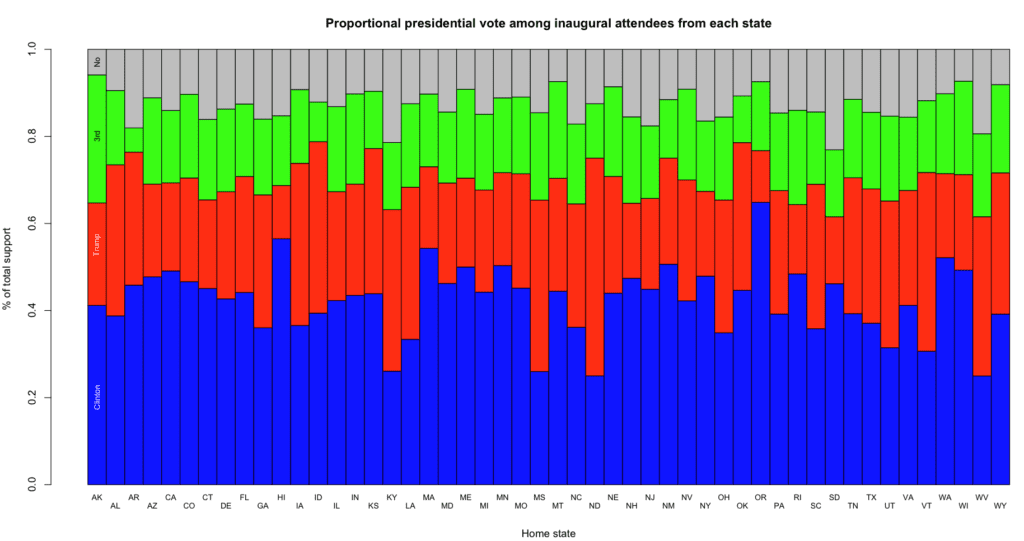Around 4:30 in the afternoon on Saturday, the Trump White House officially introduced the world to “alternative facts” by claiming that Donald Trump’s inauguration was the most watched and most attended inauguration in the history of the nation. This announcement went unnoticed by me at the time because I was standing with 499,999 of my closest friends at the edge of the South Lawn, saturating cellphone networks to the point where phones no longer functioned – forcing us to talk amongst ourselves instead of scrolling through news feeds….
Sunday afternoon I decided to further investigate what our data and models had to say about inaugural crowds. In other words, here are some alternative facts backed by petabyte-scale data and the same statistical methods that underlie medical diagnoses. In particular, I was curious to know how inaugural visitors broke down along state and partisan lines. Where did Inauguration Weekend visitors come from? Previously, I demonstrated that Hillary Clinton voters were outnumbering Trump voters, but was this case for every state? What about 3rd party and non-voters?
I found that attendees came from every state in the nation. In aggregate, Clinton’s delegation accounted for 43% of all visitors whereas Trump’s voters made up around 25% of all out of state visitors to DC this weekend. Coming in next were third party voters with 17%, followed by non-voters with 15%. Put another way, the majority of people who came to DC for Inauguration Weekend did not vote for President Trump. Note that this analysis does not include DC residents, which would further tip the scales towards the opposition.
This general pattern was largely consistent state by state (see below figure), and for no state were Trump voters the clear dominant group under an “us-vs-them” lens. In fact, I only found Trump majorities in Iowa, Kentucky, Louisiana, Mississippi, North Dakota, Utah, Vermont, and West Virginia. Truth be told, Kentucky and West Virginia are the only states with robust sample sizes and a substantial majority relative to Clinton voters, with a ratio of around 1.4 Trump voters for every Clinton voter. What about the Rust Belt collation that put him in the White House? Florida? North Carolina? These “alternative, Big Data facts” point to an overwhelming anti-mandate among the citizens that traveled to Washington.
But that beaming signal of rejection belies subtleties that characterize the current state of the anti-Trump movement: the legions of protesters who assembled were not only drawn from across the United States, they were also drawn from across a spectrum of progressive issues. Our data shows the top issues for protesters were women’s rights, civil rights, refugee rights and environmental rights. It’s obvious that these interests did not form a viable electoral coalition in November and it will take an incredible effort to maintain and cultivate them until at least mid-term elections.
This weekend also demonstrated the news media has begun to adopt novel strategies for reporting on the Trump administration including restricting live coverage and much more direct responses to commentary that dovetails from reality. Indeed, there’s no disputing that subscriptions to major news outlets including the New York Times and the Washington Post are on the rise. But will any of these new strategies and new viewership matter if they are not breaking into populations of citizens who preferentially consume “alternative facts?”
What does all this mean and where do we go from here? Whatever your political leanings are there’s no disputing this weekend was a historic one. For those who traveled out of rejection, the path forward is beset with substantial challenges – be it motivating and keeping a diverse base on message, expanding media consumption into non-traditional audiences, or challenging in real-time the administration’s facts. For those who traveled out of support or stayed home to watch, the challenge remains in keeping the Trump base mobilized, supportive and protective of the administration’s claims and strategy in the face of a mainstream media that’s off to a rocky relationship with the president and eagerly prepared to challenge the administration at the podium.
We are ready to tackle all these, and more.
What alternative facts do you prefer?
Dr. Daniel Scantlebury is a Data Scientist at Resonate




